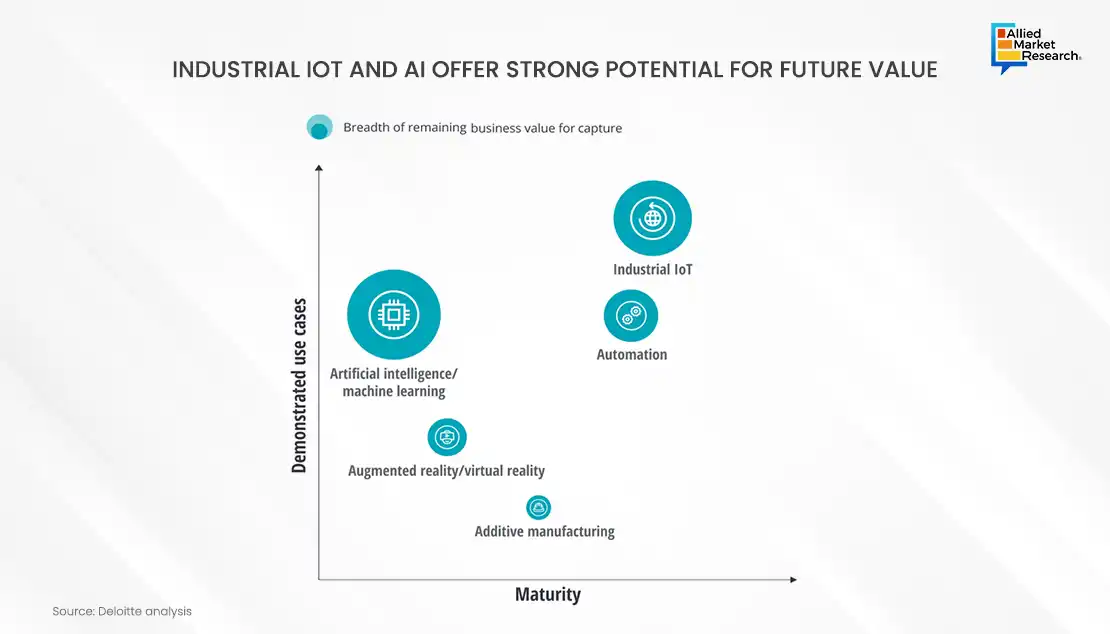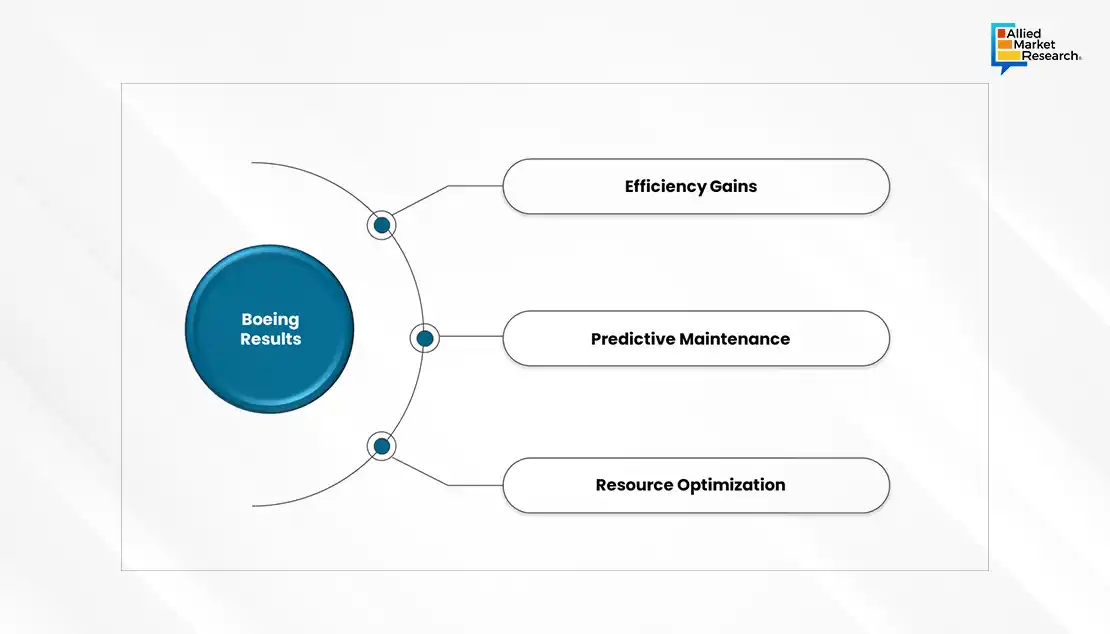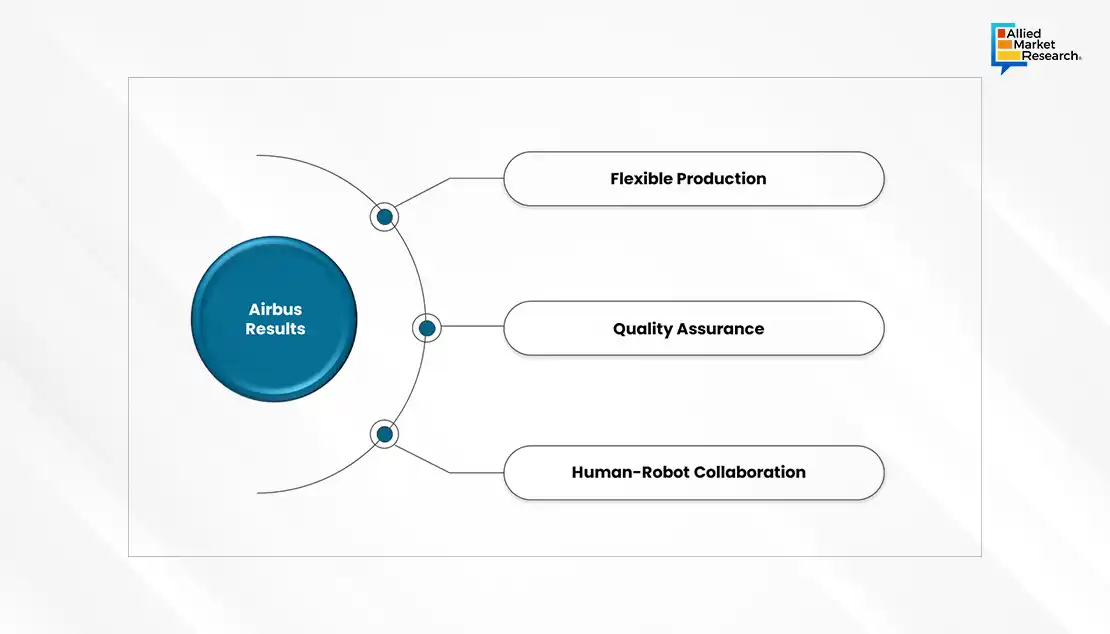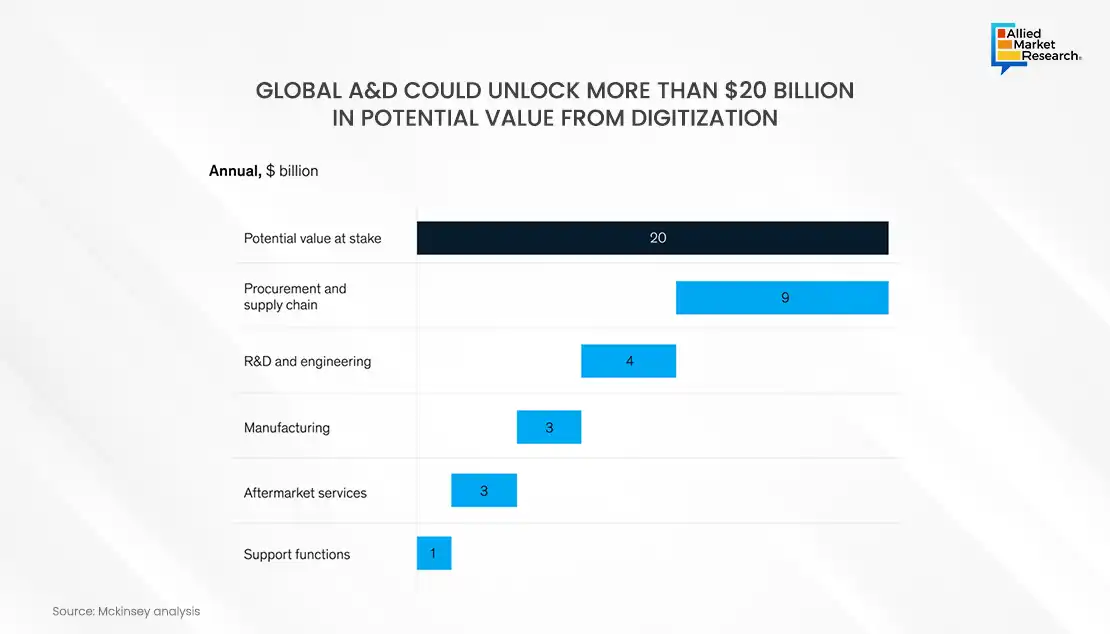Table Of Contents
- The Foundation of Smart Manufacturing
- Driving Advanced Manufacturing in Aerospace and Defense
- The Impact on Aerospace Manufacturing
- CASE STUDY
- Boeing Case Study: Optimizing Production Efficiency with IoT Integration
- Airbus Case Study: Enabling Flexible Manufacturing with Robotics and AI
- Exploring the Path ahead
- Conclusion

Lalit Janardhan Katare

Koyel Ghosh
Evolution of Smart Manufacturing in Aerospace

In the past, making airplanes involved a lot of hands-on work in the aerospace industry. Skilled workers carefully crafted each part by hand, following detailed blueprints and using their expertise. Even though they aimed for precision, there were challenges in keeping up with the growing demand, handling complicated designs, and ensuring strict safety standards. This period, known for its craftsmanship, had some limitations due to the manual methods used.
The aerospace sector recognized the necessity for technological advancements and increased efficiency, prompting the emergence of advanced manufacturing, also known as smart manufacturing. Smart manufacturing, in the aerospace industry, involves integrating of the cutting-edge technologies like robotics, the Internet of Things (IoT), cloud computing as well as data driven processes to boost productivity, efficiency, and flexibility in aerospace manufacturing and production activities. This approach utilizes automation, data analysis, and connectivity to optimize phases of the manufacturing process. The main objective of smart manufacturing is to establish an interconnected manufacturing ecosystem that can adapt to evolving needs enhance quality, cut costs and drive innovation.
Key components of smart manufacturing in aerospace include use of the following components:
- Industrial Internet of Things (IIoT)
- Advanced Robotics
- Artificial Intelligence (AI) and Machine Learning (ML)
- Digital Twins
- Additive Manufacturing (3D Printing)
- Cloud Computing
- Augmented Reality (AR) and Virtual Reality (VR)
- Cybersecurity Measures
- Advanced Analytics
- Interconnected Supply Chain
By combining above stated technologies and principles, aerospace smart manufacturing aims to create a more agile, adaptive, and efficient production environment. It not only improves the manufacturing process but also contributes to the development of innovative aerospace products and solutions. For instance, Spirit AeroSystems (one of the world’s largest tier 1 manufacturers and suppliers of aerostructures) has upgraded its 80-year-old facility to digitize its manufacturing operations and lay the groundwork for a 21st-century smart factory.
“This smart factory has really helped streamline our factory flows, make them leaner, and ultimately improve our productivity, our delivery, and our quality”
—Thomas Gentile, president and CEO, Spirit AeroSystems
Smart manufacturing is revolutionizing the aerospace sector by automating, digitizing, and integrating manufacturing and design data. This is changing traditional practices and paving for a new era of efficiency and innovation.
The Foundation of Smart Manufacturing
At its foundation, smart manufacturing represents a transition from conventional manufacturing practices to focusing on the seamless integration of digital technologies into every aspect of the production cycle. Smart manufacturing is revolutionizing the aerospace industry with its focus on precision, reliability, and innovation.
Optimizing Efficiency through Data-Driven Insights: Smart manufacturing allows data analytics and AI algorithms to extract actionable insights from the vast amount of data generated during aerospace production. This data-driven approach allows manufacturers to optimize processes, identify bottlenecks, and enhance overall operational efficiency. Real-time monitoring and predictive analytics enable proactive decision-making, reducing downtime, and improving resource utilization.
Various smart factory solution providers have already deployed their solutions successfully to boost efficiency. For instance, in Sept 2023, Infosys implemented the smart factory solution at three of the company’s maintenance, repair, and overhaul (MRO) facilities in Singapore, connecting more than 100 machines. This smart factory solution sorted the problems related to delivery delays and cost overruns and improved the efficiency from 57% to 70%.
Automation Redefining Aerospace Workflows: The automation is one of the important aspects of smart manufacturing. In aerospace, this translates to the deployment of robotic systems and autonomous machinery on the factory floor to automate few or all of the operations. Automated assembly lines not only accelerate production but also ensure precision and consistency, mitigating the risk of errors associated with manual labor work.
For instance, the manufacturing teams at Boeing utilize smart tags to locate available or misplaced inventory. Additionally, digital tooling applications connected to factory-wide smart tags monitor usage and generate new orders precisely when a replacement is needed. In Boeing's production and tooling divisions, the focus is on ensuring that technicians always have the necessary tools readily available for their work.
Driving Advanced Manufacturing in Aerospace and Defense
Industrial Internet of Things (IIoT): The Industrial Internet of Things stands out as a mature and widely embraced technology in various industries, particularly in aerospace. Serving as the prime force binding the network, IIoT facilitates the seamless generation and communication of data. With sensors and connected devices, it produces a lot of data for quick insights and actions. A major example is predictive maintenance, where machine performance indicators such as amperage draw, temperature, and speed are monitored. This not only optimizes worker utilization but also informs and predicts potential part or equipment failures by comparing real-time data to historical performance. Furthermore, by integrating real-time machine status with RFID-tracked inventory, we can establish a basis for dynamic routing algorithms. This enables efficient allocation of resources and proactive staging of materials.
AI and Machine Learning (AI/ML): While still in its early stages within the aerospace industry, AI and machine learning (AI/ML) show increasing promise across the entire value chain, potentially rivaling IIoT. The substantial influx of data from connected manufacturing systems, coupled with more powerful algorithms, has positioned AI as integral to the manufacturing process. Beyond traditional shop floor applications, AI/ML finds utility in computer vision, generative design, natural language processing, and autonomous decision-making. Its role extends to gathering and analyzing data about aircraft in use, enabling predictive maintenance, air traffic control, and a deeper understanding of air traffic patterns. A&D companies are exploring the diagnostic potential of AI/ML for identifying in-flight issues and expediting repairs between flights. Additionally, AI/ML applications have proven valuable in helping aerospace companies adapt and respond to fluctuations induced by the COVID-19 pandemic.
Automation: While the application of automation across the entire value chain may not be as extensive, its potential value remains significant. Within the supply chain, autonomous robots contribute to cost reduction, increased productivity, and enhanced human worker performance. In the aerospace sector, where the production scale is relatively smaller compared to other industries, the application of autonomous technologies demands a compelling business case. Experimentation with multiple uses for automation, starting with smaller-scale pilots, can strengthen the investment case. Aerospace executives emphasize the importance of maintaining flexibility and portability in automation, especially given the industry's frequent job-shop operations.

Augmented and Virtual Reality (AR/ VR): The value of Augmented and Virtual Reality is firmly established, with a focus on specific, discrete needs. AR/VR is extensively used in training, maintenance tasks, and design processes. It consolidates data from the entire value chain to visualize and understand the physical components of aircraft, making it valuable in the early stages of design and manufacturing. The technology's applications extend to creating 3D work instructions, simulating aircraft designs for customers, and facilitating collaboration among design engineers and supply chain professionals. Manufacturers are using AR to show logos and paint designs on airplane bodies,, allowing customers to view and modify exterior designs without the need for costly repainting.
Additive Manufacturing: Additive Manufacturing is widely discussed in aerospace for tasks like modeling, prototyping, tooling, lightweighting, and fabrication of complex or low-volume parts. Recent developments in AM include new metallic alloys, reduced material costs, and faster production times. The integration of AI and ML enables Original Equipment Manufacturers (OEMs) to leverage information from the digital thread for generative design and parts optimization. However, challenges persist, particularly in the certification process for AM-produced parts. As of now, AM is not widely used for primary aerostructures due to the rigorous certification requirements and the need for FAA approval. Despite these challenges, AM is highly important in manufacturing, offering valuable solutions for the shop floor and production processes.
The Impact on Aerospace Manufacturing
The adoption of smart manufacturing in the aerospace sector reverberates across various dimensions, bringing about tangible benefits and fostering a culture of continuous improvement.
- Enhanced Quality Assurance and Safety: Smart manufacturing technologies bring a fresh approach to quality assurance and safety in aerospace. AI-powered systems facilitate real-time monitoring of manufacturing processes, enabling immediate detection of deviations from predefined standards. This not only ensures the production of high-quality components but also enhances safety protocols by identifying potential hazards before they escalate.
- Supply Chain Resilience and Flexibility: In the aerospace industry, supply chains are complex, and any delays or problems can cause significant issues. Smart manufacturing enhances supply chain resilience by providing end-to-end visibility into the production cycle. Manufacturers can adapt quickly to changes in demand, optimize inventory levels, and respond promptly to unforeseen challenges, ensuring a more agile and robust supply chain ecosystem.
- Empowering the Workforce: Smart manufacturing doesn't replace jobs but instead creates new roles and requires workers to have higher skills. The collaboration between humans and machines becomes a new way of working, with skilled workers supervising and improving automated processes. Workforce development programs become essential to equip employees with the necessary skills to navigate this technological shift.
- Driving Innovation: Smart manufacturing boosts innovation in aerospace by encouraging collaboration among manufacturers, tech providers, and researchers. This leads to faster development and adoption of advanced solutions. This innovation extends beyond production processes to product design, materials science, and sustainable practices, positioning the aerospace sector at the forefront of technological advancement.
CASE STUDY
Boeing Case Study: Optimizing Production Efficiency with IoT Integration
Background: Boeing, a renowned aerospace manufacturer, faced challenges in optimizing its production processes for commercial aircraft. The complexity of assembly lines and varying production demands required a more efficient and data-driven approach.
Solution: Boeing implemented a smart manufacturing solution leveraging IoT technologies. They integrated sensors from PTC's ThingWorx platform across the manufacturing floor to collect real-time data on equipment performance, production rates, and resource utilization. This data was analyzed using analytics tools provided by Siemens Digital Industries Software.

Results:
- Efficiency Gains: With real-time insights, Boeing identified bottlenecks and optimized production flows, resulting in a 15% improvement in overall efficiency.
- Predictive Maintenance: IoT sensors enabled predictive maintenance, reducing machine downtime by 20% as issues were addressed proactively.
- Resource Optimization: Boeing achieved a 10% reduction in energy consumption and raw material waste through better resource utilization.
Airbus Case Study: Enabling Flexible Manufacturing with Robotics and AI
Background: Airbus, a leading aerospace component manufacturer, needed to enhance flexibility in its production processes to accommodate changing product specifications for various aircraft models.

Solution: Airbus implemented a smart manufacturing solution that integrated robotics and AI. They deployed collaborative robots (cobots) from Universal Robots alongside human workers and utilized AI algorithms provided by IBM Watson to analyze historical production data and predict future demand.
Results:
- Flexible Production: The integration of robotics allowed Airbus to quickly adapt to changing product specifications, reducing time-to-market by 25%.
- Quality Assurance: IBM Watson's AI algorithms identified potential defects early in the production process, resulting in a 30% reduction in defects and improved product quality.
- Human-Robot Collaboration: The collaborative nature of human-robot interaction led to a 15% increase in overall productivity and job satisfaction among Airbus employees.
Exploring the Path ahead
Smart manufacturing is bringing about notable changes in the aerospace industry, shaping its future. From the adoption of digital twins for virtual prototyping to the integration of blockchain for transparent and secure supply chain management, the future holds immense possibilities.
Digital Twins and Virtual Prototyping: Digital twins, virtual copies of real-world objects like aircraft, are really helpful in aerospace manufacturing. They let manufacturers test and improve performance on a computer before making the real thing, which saves time and money.

Blockchain for Transparent and Secure Processes: The integration of blockchain technology ensures transparency and security in aerospace manufacturing. From tracking the provenance of materials to securing digital transactions in the supply chain, blockchain establishes an immutable and auditable record. This not only enhances trust among stakeholders but also mitigates the risk of counterfeit components entering the aerospace ecosystem.
Conclusion
Smart manufacturing goes beyond just upgrading technology; it's a whole new way of doing things in aerospace manufacturing. In a world of global competition, environmental challenges, and changing customer expectations, smart manufacturing stands out as a symbol of innovation and efficiency. Embracing this transformative approach has the potential to not only propel aerospace manufacturers into the future but also to redefine our understanding of what is possible in the skies and beyond. The growing shift of the aerospace sector towards smart manufacturing is expected to shape the dynamics of the sector in the coming period.
At Allied Market Research, we're here to help businesses and their stakeholders in the aerospace industry understand and adopt environmentally friendly practices. We provide valuable insights into sustainable strategies that not only align with global environmental goals but also boost corporate reputation and meet customer expectations. Our focus is on smart manufacturing practices, introducing advanced technologies, and efficient processes to help aerospace companies thrive in an industry that values innovation and environmental responsibility. With our straightforward guidance, businesses can make informed decisions and succeed in a sustainable and smart aerospace industry.

